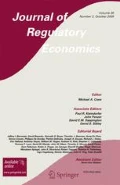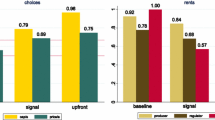Abstract
Price caps, while widely touted, are less commonly implemented. Most incentive schemes involve profit sharing and are, thus, variants of sliding-scale regulation. I show that, relative to price caps, some degree of profit sharing always increases expected welfare. Numerical simulations show that welfare may be enhanced by large amounts of profit sharing and by granting the firm a greater share of gains than of losses. Simulations also suggest profit sharing is most beneficial when the firm's initial cost is high and cost-reducing innovations are difficult to achieve but offer the potential for substantial savings.
Similar content being viewed by others
References
Armstrong, Mark, Simon Cowan, and John Vickers. 1994. Regulatory Reform: Economic Analysis and British Experience. Cambridge, MA: The MIT Press.
Banks, Jeffrey S. 1992. “Monopoly Pricing and Regulatory Oversight,” Journal of Economics and Management Strategy 1: 203–233.
Braeutigam, Ronald R., and John C. Panzar. 1993. “Effects of the Change from Rate-of-Regulation to Price-Cap Regulation.” American Economic Review 83: 191–198.
Braeutigam, Ronald R., and James P. Quirk. 1984. “Demand Uncertainty and the Regulated Firm.” International Economic Review 25: 45–60.
Cabral, Luis M. B., and Michael H. Riordan. 1989. “Incentives for Cost Reduction under Price Cap Regulation,” Journal of Regulatory Economics 1: 93–102.
Clemenz, Gerhard. “Optimal Price Cap Regulation”. 1991. Journal of Industrial Economics 39: 391–408.
California Public Utilities Commission. 1990. “Order Instituting Rulemaking on the Commission's own motion to change the structure of gas utilities' procurement practices and to propose refinements to the regulatory framework for gas utilities,” R.90-02-008.
Cromwell, Jerry, Randall P. Ellis, Brooke Harrow, and Thomas P. McGuire. 1991. A Modified TEFRA System for Medicare Discharges from Psychiatric Facilities. Mimeo, Boston University.
Fitzpatrick, Mary. 1987. “A Test of Passive Regulation using an Endogenous Switching Regression.” Discussion Paper EAG 87-5, U.S. Department of Justice, Antitrust Division, Economic Analysis Group.
Gasmi, F., M. Ivaldi, and J.J. Laffont. 1994. “Rent Extraction and Incentives for Efficiency in Recent Regulatory Proposals.” Journal of Regulatory Economics 6: 151–176.
Greenstein, Shane, Susan McMaster, and Pablo T. Spiller. 1995. “The Effect of Incentive Regulation on Infrastructure Modernization: Local Exchange Companies' Deployment of Digital Technology.” Journal of Economics and Management Strategy 4: 187–236.
Indiana Utility Regulatory Commission. 1990. Petition of Public Service Company of Indiana, Inc., for the Approval of Permanent Rates.... Cause No. 37414-S2.
Joskow, Paul. 1974. “Inflation and Environmental Concern: Structural Change in the Process of Public Utility Regulation.” Journal of Law and Economics 17: 291–327.
Joskow, Paul, and Richard Schmalensee. 1986. “Incentive Regulation for Electric Utilities.” Yale Journal on Regulation 4: 1–50.
Kahn, Alfred E. 1989. The Economics of Regulation. Cambridge, MA: The MIT Press.
Laffont, Jean-Jacques, and Jean Tirole. 1993. A Theory of Incentives in Procurement and Regulation. Cambridge, MA: The MIT Press.
Lyon, Thomas P. 1995. “Regulatory Hindsight Review and Innovation by Electric Utilities.” Journal of Regulatory Economics 7: 233–254.
Lyon, Thomas P., and Haizhou Huang. Forthcoming. “Innovation and Imitation in an Asymmetrically-Regulated Industry.” International Journal of Industrial Organization.
Majumdar, Sumit K. 1995. “Regulation and Productive Efficiency: Evidence from the U.S. Telecommunications Industry.” Working Paper 9504-14, School of Business Administration, University of Michigan.
Milgrom, Paul, and Chris Shannon. 1994. “Monotone Comparative Statics.” Econometrica 62: 157–180.
Peltzman, Sam. 1976. “Toward a More General Theory of Regulation.” Journal of Law and Economics 19: 211–248.
Pint, Ellen M. 1992. “Price-Cap versus Rate-of- Return Regulation in a Stochastic-Cost Model.” The RAND Journal of Economics 23: 564–578.
Rogerson, William P. 1985. “The First-Order Approach to Principal-Agent Problems.” Econometrica 53: 1357–1367.
Sappington, David E. M., and David S. Sibley. 1992. “Strategic Nonlinear Pricing under Price-Cap Regulation.” The RAND Journal of Economics 23: 1–19.
Sappington, David E.M., and Dennis L. Weisman. Forthcoming. Designing Incentive Regulation for the Telecommunications Industry, Cambridge, MA: The MIT Press.
Schmalensee, Richard. 1989. “Good Regulatory Regimes.” The RAND Journal of Economics 20: 417–436.
Stefos, Theodore, Nicole Lavallee, and Frank Holden. 1992. “Fairness in Prospective Payment: A Clustering Approach.” Health Services Research 27: 239–261.
Weisman, Dennis L. 1993. “Superior Regulatory Regimes in Theory and Practice.” Journal of Regulatory Economics 5: 355–366.
Author information
Authors and Affiliations
Additional information
This paper has benefitted from the comments of Mark Bagnoli, Jim Burgess, Michael Crew, Steve Hackett, Paul Kleindorfer, Michael Riordan, Ted Stefos, Ingo Vogelsang, Dennis Weisman, two anonymous referees, and workshop participants at the First Annual Northeastern Health Economics Conference, the Fourth Annual Health Economics Conference, GTE, Indiana University, the Rutgers Advanced Workshop in Regulation and Public Utility Economics, and the 20th Telecommunications Policy Research Conference. Financial support from the Management Science Group of the Department of Veterans Affairs and from Indiana University is gratefully acknowledged.
Rights and permissions
About this article
Cite this article
Lyon, T.P. A model of sliding-scale regulation. J Regul Econ 9, 227–247 (1996). https://doi.org/10.1007/BF00133475
Issue Date:
DOI: https://doi.org/10.1007/BF00133475



